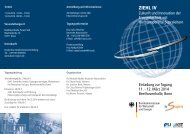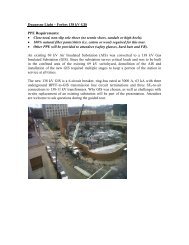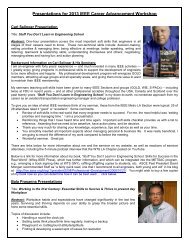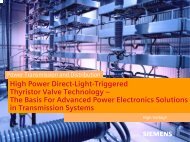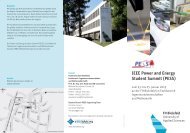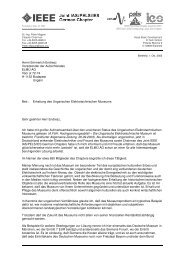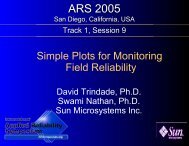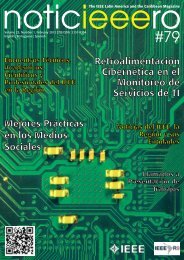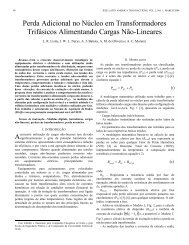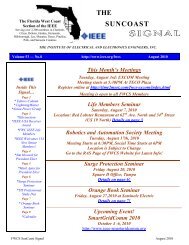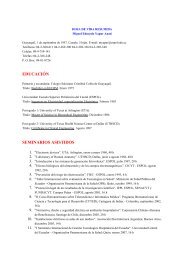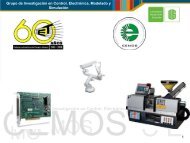continued from page 1 - IEEE Entity Web Hosting IEEE Entity Web ...
continued from page 1 - IEEE Entity Web Hosting IEEE Entity Web ...
continued from page 1 - IEEE Entity Web Hosting IEEE Entity Web ...
You also want an ePaper? Increase the reach of your titles
YUMPU automatically turns print PDFs into web optimized ePapers that Google loves.
Consumer Electronics<br />
Society<br />
Newsletter<br />
From the President<br />
William Lumpkins<br />
Wi2Wi Inc.<br />
xillia@ieee.org<br />
My last year and my last article for the <strong>IEEE</strong> Consumer<br />
Electronics Society Newsletter as President is<br />
both a joyous and slightly sad reminder of growth<br />
in all of our lives. I have truly enjoyed helping out<br />
with the society, I have learned a lot through many of the senior volunteers<br />
in our Society and <strong>from</strong> the numerous suggestions I have received<br />
these past two years. I want to give special thanks to Charlotte Kobert,<br />
our Executive Assistant-Conference Organizer-Committee Support person.<br />
She has been instrumental in helping keep our Society on track for<br />
many years and I am sure she will continue to do so with the next President<br />
and our new recently voted in AdCom members.<br />
I would like to welcome the recently elected Administrative Committee<br />
members for 2009, Dr. Robin Sarah Bradbeer, Dr. Tomohiro Hase,<br />
Wayne C. Luplow, Brian Markwalter and myself. Our terms will expire<br />
on 31 December 2011. I want to thank Stefan Mozar who has valiantly<br />
enabled the CE Society to try Electronic Balloting this year, though a bit<br />
costly, I think it was worth the increase in participation. We will try to<br />
use electronics balloting next year and hopefully we will be able to<br />
reduce the cost as well. As always, we need volunteers, please consider<br />
running for next year’s open AdCom slots as well as volunteering to<br />
our many open committee positions. Please contact Stefan Mozar at<br />
s.mozar@ieee.org.<br />
I am pleased to announce two new CE Chapters that have joined<br />
our fold, the recently approved Beijing, main point of contact (Dong<br />
Liu at dliu@biigroup.com), and Malaysia, main point of contact Abd<br />
Ramli at (arr@eng.upm.edu.my) chapters were formed and we wish<br />
them well in increasing their membership and activities in their respective<br />
areas. We hope to hear more <strong>from</strong> them in the near future. If you<br />
are interested in starting a chapter in your area, please do not hesitate<br />
to contact Stefan Mozar for further info.<br />
Recently I went to see Eagle Eye, an exciting adventure with a twist<br />
relating to Artificial Intelligence (AI). Of course with most things in<br />
Hollywood the level of reality is not proportional to the level of technology<br />
involved in the story line but hey, it’s a movie! At least people<br />
are more aware of the concept of AI. Along with the recent <strong>IEEE</strong> Spec-<br />
Fall 2008 ■ Number 4<br />
http://ewh.ieee.org/soc/ces/<br />
Table of Contents<br />
From the President .................1<br />
AdCom Members .................2<br />
CES Invades 2008 <strong>IEEE</strong> Sections Congress 3<br />
ICCE 09 Schedule-At-A-Glance ......4<br />
Digital Storage in Consumer Electronics . 6<br />
TI-MSP430 Demo Kits for CE Society<br />
Student Chapters. .................8<br />
Keynote Speakers at ICCE ...........8<br />
Short Circuits.........................9<br />
Letters to the Editor ................10<br />
SMPTE. ..........................12<br />
Call for Papers ....................12<br />
CEA Projects .......................13<br />
Sampling the Consumer Electronics<br />
Tranactions Over 100 Papers to Choose<br />
From...............................14<br />
CES Turns the Spotlight on Students ....15<br />
ICCE 2009 ..........................16<br />
click<br />
go to www.ieee.org, To join, as a member. you wants Society<br />
<strong>continued</strong> on <strong>page</strong> 3<br />
Electronics Consumer<br />
issn 1082-748XThe <strong>IEEE</strong><br />
on “membership.” Click, “Join a Society.” You will be able to add CE Society membership if you are<br />
already an <strong>IEEE</strong> member, or you will be able to join as an affiliate if you are not an <strong>IEEE</strong> member.
2008 CHAPTER CHAIRS<br />
BEIJING<br />
DONG LIU<br />
dliu@biigroup.com<br />
BENELUX<br />
KEES A IMMINK<br />
immink@turing-machines.com<br />
CHICAGO-JT. CHAPTER<br />
AryE NEhOrAI<br />
nehorai@ece.uic.edu<br />
DALLAS<br />
SUE hUI<br />
shui@ti.com, suehui2000@yahoo.com<br />
HONG KONG<br />
KF TSANG<br />
ee330015@cityu.edu.hk<br />
JAPAN<br />
TAIIChIrO KUrITA<br />
kurita.y-hm@nkh.or.jp<br />
MALAYSIA<br />
ABD rAMLI<br />
arr@eng.upm.edu.my<br />
OTTAWA-JT. CHAPTER<br />
IAN GLENN<br />
ian.glenn@ieee.org<br />
PHILADELPHIA-CHAPTER<br />
GAIL rOSEN<br />
gailr@mail.ece.drexel.edu<br />
PORTUGAL CE/CAS/BT JT. CHAPTER<br />
ANTONIO NAvArrO<br />
navarro@av.it.pt<br />
PRINCETON-CENTRAL JERSEY-JT. CHAPTER<br />
PADMANABhA rAjAGOPALAN<br />
prajagopalan@gmail.com<br />
RUSSIA<br />
DMITry TKAChENKO<br />
dtkach@mail.wplus.net<br />
SANTA CLARA VALLEY<br />
GAry SASAKI<br />
gary.sasaki@digdia.com<br />
SINGAPORE<br />
EE PING ONG<br />
epong@i2r.a-star.edu.sg<br />
TAIPEI<br />
TIhAO ChIANG<br />
tchiang@mail.nctu.edu.tw<br />
UK&RI<br />
SCOTT LINFOOT<br />
slinfoot@dmu.ac.uk<br />
STUDENT CHAPTERS<br />
St. Petersburg Chapter<br />
UC Santa Cruz Chapter<br />
George Mason University Chapter<br />
Newsletter Deadlines<br />
December 15 - Winter, 2008<br />
March 15 - Spring, 2009<br />
june 15 - Summer, 2009<br />
CE SOCIETY NEWSLETTER<br />
EDITORIAL BOARD<br />
Editor<br />
jim Farmer, jofarmer@mindspring.com<br />
Associate Editors<br />
Stefan Mozar, s.mozar@ieee.org<br />
Bernard Fong, bfong@ieee.org<br />
jianping Zhou, jianping.zhou@gmail.com<br />
Tom Caughlin, tom@tomcoughlin.com<br />
Stu Lipoff, stu@lipoff.org<br />
George hanover, georgehanover@att.net<br />
Samad Ahmadi, sahmadi@dmu.ac.uk<br />
<strong>IEEE</strong> CONSUMER ELECTRONICS SOCIETY<br />
2008 ADMINISTRATIVE COMMITTEE<br />
Term Expires 2008<br />
William Lumpkins<br />
President<br />
Wi2Wi Inc.<br />
2107N. 1st Street Ste 540<br />
San jose. CA 95131<br />
xillia@yahoo.com<br />
james O. Farmer<br />
Newsletter Editor<br />
Wave7 Optics Inc<br />
1075 Windward ridge<br />
Parkway, Suite 170<br />
Alpharetta, GA 30005<br />
jofarmer@mindspring.com<br />
Stefan Mozar<br />
2nd vice President-International<br />
Affairs/Chapter relations<br />
& Nominations Chair<br />
44 Meurants Lane<br />
Glenwood NSW 2768 Australia<br />
s.mozar@ieee.org<br />
r. Simon Sherratt<br />
2009 ICCE Chairman,<br />
vP of Conferences<br />
University of reading<br />
School of Systems Engineering<br />
reading rG6 6Ay<br />
United Kingdom<br />
R.S.Sherratt@Reading.ac.uk<br />
Term Expires 2009<br />
Tzy-hong Steve Chao<br />
Student Membership<br />
Subcommittee<br />
Industrial Technology<br />
Investment Corporation<br />
National Chiao-Tung University<br />
No 16, Alley 3, Lane 168,<br />
Edison road<br />
Bao-Shan Township<br />
hsinchu County<br />
308 Taiwan, r.O.C.<br />
stevechao@giga.net.tw<br />
Tom Coughlin<br />
Coughlin Associates<br />
1665 Willowmont Ave<br />
San jose CA 95124-3234<br />
tom@tomcoughlin.com<br />
George hanover<br />
Membership & Student<br />
relations<br />
Consultant to the Consumer<br />
Electronics Industry<br />
4139 Evergreen Drive<br />
Fairfax, vA 22032-1018<br />
georgehanover@att.net<br />
Uwe E. Kraus<br />
University of Wuppertal<br />
rainer-Gruenter-Str. 21<br />
Building FE 42119<br />
Wuppertal, Germany<br />
krausue@uni-wuppertal.de<br />
Ulrich reimers<br />
First vice President<br />
& Fellow Evaluator<br />
Institute for Communications<br />
Technology<br />
Braunschweig Technical<br />
University<br />
Schleinitzstrasse 22<br />
38092 Braunschweig<br />
Germany<br />
u.reimers@tu-bs.de<br />
Term Expires 2010<br />
Stephen D. Dukes<br />
Imaginary Universes, LLC.<br />
370 N. East Camano Drive<br />
Suite 5, #451<br />
Camano Island, WA 98282<br />
stephendukes@verizon.net<br />
ralph justus<br />
EIA Standards & Technology<br />
Electronic Components,<br />
Assemblies<br />
and Materials Association<br />
2500 Wilson Boulevard<br />
Arlington, vA 22201-3834<br />
rjustus@ecaus.org<br />
Scott Linfoot<br />
De Montfort University<br />
School of Engineering and<br />
Technology<br />
Queen’s Building<br />
The Gateway<br />
Leicester<br />
UK<br />
LE1 9Bh<br />
sllinfoot@dmu.ac.uk<br />
Leander h. hoke, jr.<br />
Treasurer<br />
613 E. Fox Den Drive<br />
Knoxville. TN. 37934<br />
L.Hoke@ieee.org<br />
Larry Zhang<br />
Awards Chairman<br />
Texas Instruments Inc.<br />
12500 TI BLvD<br />
Dallas, TX 75243<br />
l-zhang1@ti.com<br />
Ex-Officio Members<br />
hans Baumgartner<br />
hans Baumgartner<br />
Past President<br />
Sarnoff Corporation<br />
933 Golden Gate Drive<br />
San Diego, CA 92116<br />
h.baumgartner@ieee.org<br />
Michael A. Isnardi<br />
representative to ATSC<br />
Sarnoff Corporation<br />
CN 5300<br />
Princeton, Nj 08534-530<br />
misnardi@sarnoff.com<br />
Stuart Lipoff<br />
Technical Activities and<br />
Standards<br />
IP Action Partners<br />
192 Kirkstall road<br />
Newton, MA. 02460<br />
s.lipoff@ieee.org<br />
AdCom Minutes:<br />
http://www.ewh.ieee.org/soc/ces/AdComMeetings.htm<br />
Wayne C. Luplow<br />
vice President of Publications &<br />
Transactions Editor<br />
Zenith Electronics Corporation<br />
2000 Millbrook Drive<br />
Lincolnshire, IL. 60069<br />
w.luplow@ieee.org<br />
Brian Markwalter<br />
CEA Liaison<br />
Consumer Electronics<br />
Association<br />
2500 Wilson Boulevard<br />
Arlington, vA. 22201-3834<br />
bmarkwalter@CE.org<br />
Teodor Buburuzan<br />
<strong>Web</strong> Master<br />
Institute for Communications<br />
Technology<br />
Technical University of<br />
Braunschweig<br />
Schleinitzstraße 22 (room 217)<br />
D - 38106 Braunschweig<br />
Germany<br />
buburuzan@ifn.ing.tu-bs.de<br />
Daniel Eisenman<br />
Student Membership vice-Chair<br />
Pragmatics Technology<br />
1275 Lincoln Ave. Suite #7<br />
San jose, CA. 95125<br />
eisenman@gmail.com<br />
Christian hentschel<br />
Distinguished Lecturer<br />
Coordinator<br />
University of Technology<br />
Cottbus<br />
Konrad-Wachsmann-Allee 1<br />
03046 Cottbus Germany<br />
christian.hentschel@tu-cottbus.<br />
de<br />
reinhard Moeller<br />
Transactions on haptics<br />
Manager<br />
University of Wuppertal<br />
Faculty E<br />
rainer-Gruenter-Str. 21, Bld. FC<br />
D - 42119<br />
Wuppertal Germany<br />
r.moeller@computer.org<br />
Charlotte Kobert<br />
AdCom Executive Administrator<br />
4115 Clendenning road<br />
Gibsonia, PA 15044<br />
ckobert@zbzoom.net<br />
<strong>IEEE</strong> Consumer Electronics Society Newsletter (ISSN 1082-748X) is published quarterly by the <strong>IEEE</strong> Consumer Electronics Society of The Institute of Electrical and<br />
Electronics Engineers, Inc. Headquarters: 3 Park Avenue, 17th Floor, New York, NY 10016-5997. An assessment of $1.00 per member per year (included in Society fee)<br />
for each member of the <strong>IEEE</strong> Consumer Electronics Society is made. This newsletter is printed in the U.S.A. Application to mail at Periodicals postage rates is<br />
pending at New York, NY and at additional mailing offices. Postmaster: Send address changes to <strong>IEEE</strong> Consumer Electronics Society Newsletter, <strong>IEEE</strong>, 445 Hoes<br />
Lane, Piscataway, NJ 08855-1331.<br />
Copyright 2008 <strong>IEEE</strong>. Permission to copy without fee all or part of any material without a copyright notice is granted provided that the copies are not made or<br />
distributed for direct commercial advantage and the title of publication and its date appear on each copy. To copy material with a copyright notice requires<br />
special permission. Please direct all inquiries or requests to <strong>IEEE</strong> Intellectual Property Rights Manager, <strong>IEEE</strong> Service Center, 445 Hoes Lane, Piscataway, NJ 08855. Tel:<br />
+1 732 562 3966, FAX: +1 732 981 8062, EMAIL: copyrights@ieee.org
From the President <strong>continued</strong> <strong>from</strong> <strong>page</strong> 1<br />
trum issue related to the Singularity<br />
Event (The point in time in which AI’s<br />
are accepted or recognized as sentient<br />
beings in our universe). I am again<br />
honored to know that the <strong>IEEE</strong> Consumer<br />
Electronics Society is in the<br />
forefront with its new Journal of AI in<br />
Games as well as Autonomous Mental<br />
Development.<br />
ICCE 2009 www.icce.org Jan 10th<br />
~ 14th is around the corner, I know<br />
that it will again be an exciting conference<br />
filled with good food, exciting<br />
lectures and the meeting of old<br />
friends with new. I am looking forward<br />
to Stu Lipoff’s newest activity<br />
for the conference, it is supposed to<br />
be a secret but I hear it involves lots<br />
of interactive games. I can’t wait. On<br />
that note, I hear good things are in the<br />
works for the Dr. Hase’s ISCE 2009<br />
www.isce2009.ryukoku.ac.jp conference<br />
May 25th ~ 28th in Kyoto, Japan.<br />
I can’t wait to try Natto Ice Cream<br />
and enjoy the cultural beauty of the<br />
Classical country side of Ancient<br />
Kyoto Japan.<br />
In closing, I want to say thanks<br />
again for being a member of the<br />
<strong>IEEE</strong> Consumer Electronics Society<br />
by helping us to bring the CE society<br />
further into the technical spotlight<br />
with so many new journals<br />
and avenues of interest. I look for-<br />
ward to working with you all at our<br />
various conferences or possibility<br />
on one of our new standards that<br />
we are developing.<br />
Thanks Again,<br />
William J. Lumpkins<br />
<strong>IEEE</strong> Consumer Electronics Society<br />
President 2006 ~ 2008<br />
(And thanks to you, Will, for the exceptional<br />
leadership you have provided to<br />
us. It truly has been a pleasure to work<br />
with you – ed.)<br />
Consumer Electronics Society Invades 2008 <strong>IEEE</strong> Sections Congress<br />
By Scott Linfoot, Society Secretary<br />
September 18-22nd 2008, Quebec, Canada<br />
was the time and place for the 2008<br />
<strong>IEEE</strong> Sections Congress. Arranged by the<br />
Quebec Section of the <strong>IEEE</strong> (Region 7), it<br />
was a melting pot of <strong>IEEE</strong> members <strong>from</strong><br />
every corner of the Earth with over 1200<br />
delegates attending.<br />
If this was a Section/Region-based<br />
congress, why was the Consumer Electronics<br />
Society represented? Well, three<br />
members of the AdCom – Scott Linfoot,<br />
Tom Coughlin and Larry Zhang were<br />
all invited as representatives of their<br />
respective sections (UK and Republic of<br />
Ireland, Santa Clara, CA and Dallas, TX<br />
respectivly) so it was an excellent opportunity<br />
to show the rest of the world that<br />
there was a Consumer Electronics Society<br />
and to demonstrate the sorts of activities<br />
that we do.<br />
As one of only three societies represented<br />
at this congress, it was an excellent<br />
opportunity to talk to other volunteers of<br />
the <strong>IEEE</strong> and to describe the goals of the<br />
CE Society.<br />
Although targeted at regional activities,<br />
there were a number of breakout sessions<br />
that were applicable to the Society.<br />
Some of the sessions included how to<br />
develop standards, the benefits to mem-<br />
bers and the roles of volunteers and how<br />
to attract them.<br />
The awards ceremony was excellent.<br />
This year’s <strong>IEEE</strong> Medal was given out to<br />
Gordon Moore for his work on semiconductor<br />
theory. This was an interesting<br />
event not totally unlike the Emmys (except<br />
without all the celebrities – although, of<br />
course, many of the people at this event<br />
are celebrities in their chosen fields)<br />
I would like, however, to share something<br />
with you all if I may. One shocking<br />
revelation that came <strong>from</strong> our presence at<br />
this congress is the few people who had<br />
realised that there was a Consumer Electronics<br />
Society. Out of the 500 or so people<br />
who visited the stand (a tally was taken to<br />
measure the impact of our presence), there<br />
were surprisingly few people who knew<br />
that the CE Society even existed (with only<br />
a handful actually being members). 100<br />
people had some idea what Consumer<br />
Electronics is all about. The remaining 349<br />
or so were totally oblivious to the existence<br />
of our highly important Society, although<br />
many of them were glad to see that there<br />
was a Society dedicated to the needs of<br />
industry instead of the many other (very<br />
respectable) societies who tend to verge on<br />
the edge of academia.<br />
Most visitors to the stand started with<br />
“so, what is the Consumer Electronics<br />
Society all about? I didn’t realise that<br />
there was one.” It was, of course, the role<br />
of Scott, Tom and Larry to educate them,<br />
and they spent 3 days convincing people<br />
of the importance of the CE Society and<br />
how it sits on the scheme of things. Many<br />
of the delegates went away with at least<br />
an appreciation of what the society is trying<br />
to achieve.<br />
All in all, the event was very positive<br />
and even if we didn’t recruit a single<br />
person (which I find it hard to believe<br />
given the number of industrialists that<br />
were present), we have taken steps to<br />
increase public awareness of the Society<br />
and its goals.<br />
On a final note, one of the things<br />
that I picked up <strong>from</strong> the congress is<br />
that there is an incentive <strong>from</strong> the <strong>IEEE</strong><br />
in that if you recommend a colleague<br />
to become a member of the <strong>IEEE</strong>, you<br />
will receive a reduction of $15 <strong>from</strong><br />
your next year’s dues (up to a maximum<br />
of $90). While you are at it, why<br />
not suggest that they join the CE Society?<br />
At $15 per year, it is certainly one<br />
of the cheaper societies yet with so<br />
many benefits.<br />
<strong>IEEE</strong> Consumer Electronics Society Newsletter/Fall 2008 3
“Here are the exciting topics you’ll hear about at the ICCE in January. To register, go to http://www.icce.org”<br />
4 <strong>IEEE</strong> Consumer Electronics Society Newsletter/Fall 2008
Many types of memory<br />
Digital Storage in Consumer Electronics<br />
Tom Coughlin<br />
published by Newnes Press (a division of Elsevier, March 2008)<br />
This is an except <strong>from</strong> a new book by this name written by our own Tom Coughlin.<br />
The author has kindly condensed the material and secured permission for us to publish it.<br />
Memory is a key element in the design<br />
of modern digital electronics. Memory<br />
allows the retention of information<br />
that can be used by the electronic system.<br />
Memory is information. This<br />
information may be computer files but<br />
it can also be digital photographs,<br />
home videos, movies, music and other<br />
personal and commercial content. The<br />
content is what makes these devices<br />
useful and digital storage is where the<br />
content resides.<br />
Electronic memory may be temporary<br />
as is the case for volatile<br />
memory, where the information it<br />
contains disappears when the power<br />
is turned off, or it may be long term<br />
memory, or non-volatile memory.<br />
Memory may be fast or slow, low<br />
power consumption or high power<br />
consumption, it may be inexpensive<br />
per byte or expensive. It may be part<br />
of the microprocessor electronics, a<br />
peripheral chip, an internal mass<br />
storage unit or an external digital<br />
storage device…<br />
Growth in digital content<br />
drives storage growth<br />
Demand for digital storage is driven<br />
by the growth in personal family<br />
content, by the growing number of<br />
entertainment devices in and around<br />
the home that require digital storage,<br />
by the increasing resolution of personal<br />
and commercial entertainment<br />
content, and by the growth in the<br />
number of channels that people can<br />
use to access all types of content.<br />
More consumers have digital still<br />
and video cameras, either as standalone<br />
devices or in convergence<br />
devices such as cell phones. Content<br />
creation devices such as digital still<br />
and video cameras are becoming a<br />
common standard application that<br />
can be built into consumer devices.<br />
In addition to being ubiquitous, camera<br />
resolutions make digital storage<br />
demands higher with time.<br />
Families today have many ways<br />
to enjoy content. No longer must<br />
they be tied to a schedule for programs<br />
on the television. Content can<br />
be recorded <strong>from</strong> broadcast, cable or<br />
satellite broadcasts on a digital video<br />
recorder to play back later. Audio or<br />
video content can be downloaded<br />
<strong>from</strong> the internet and listened to on a<br />
variety of static and mobile devices<br />
such as MP3 players and personal<br />
media players (PMPs). This content<br />
is likely to be stored on personal<br />
computers and possibly backed up<br />
to external storage devices.<br />
In an increasing number of homes<br />
content may be stored in a network<br />
storage device and made available<br />
through a wired or wireless network<br />
to various static and mobile devices<br />
throughout the home. Even automobiles<br />
are increasingly containing digital<br />
content for entertainment and<br />
navigation purposes. In the future all<br />
of these mobile and static devices may<br />
be part of far more comprehensive<br />
home storage network architecture.<br />
Content sharing and access is<br />
growing enormously. Content can<br />
be downloaded <strong>from</strong> the internet<br />
and watched now or later, it can be<br />
brought down to a cell phone<br />
through the mobile phone network<br />
and is can be shared with everyone<br />
via the many growing social networking<br />
web sites.<br />
In all cases the resolution of the content<br />
that people want is increasing.<br />
Content is compressed for two basic<br />
reasons. First, it is compressed to get<br />
through slow network connections and<br />
to speed up downloading. Second, it is<br />
compressed to conserve digital storage<br />
space required. Compression can be<br />
lossy or loss-less. Lossy compressed<br />
content cannot be reconstructed to its<br />
original resolution whereas loss-less<br />
content can be reconstructed using<br />
decompression technology.<br />
With increasing internet connection<br />
speeds and the low cost of digital<br />
storage capacity today we are<br />
likely to see changes in the resolution<br />
of content people may want.<br />
For instance MP3 files are a lossy<br />
compressed format where up to 90%<br />
of the original content file is lost during<br />
compression. The compression<br />
is done with a very fine human hearing<br />
compression model so in a noisy<br />
environment and with less than optimal<br />
acoustic equipment you probably<br />
can’t tell that there is content<br />
missing. With faster internet speeds<br />
and low cost storage there is beginning<br />
to be a pronounced shift <strong>from</strong><br />
MP3 to less compressed or even lossless<br />
compressed music formats…<br />
(Table 1.1) can give us an estimate<br />
of the acceptable size of storage for<br />
various applications at various resolutions,<br />
following are some examples:<br />
• A 4-megapixel photo viewer with<br />
20,000 images needs 20 GB<br />
• A 8-megapixel photo viewer with<br />
20,000 images needs 40 GB<br />
• A 10,000 song MP3 player needs 40 GB<br />
• A 10,000 song high definition<br />
(HiD) player (like a compressed<br />
DVD audio) needs 1.5 TB<br />
• A 100 movie player at VGA resolution<br />
needs 70 GB<br />
• A 100 movie player at DVD resolution<br />
needs >400 GB<br />
• A combination 20k 4-Mpixel photo,<br />
10k MP3 song, 100 VGA movie<br />
player needs 130 GB<br />
• A combination 20k 8-Mpixel photo,<br />
10k HiD song, 100 DVD movie<br />
player needs 1.75 TB<br />
<strong>IEEE</strong> Consumer Electronics Society Newsletter/Fall 2008 5
Consumer product price<br />
and demand<br />
There are significant differences<br />
between the retail and service markets<br />
for consumer electronic devices. The<br />
retail market is primarily a push market<br />
where retailers advertise products<br />
and offer various marketing approaches<br />
and discounts to persuade potential<br />
customers to make purchases. By contrast,<br />
the service market, typified by<br />
call phone and cable companies, offers<br />
the consumer electronics hardware for<br />
free, at a discount, or on a low-cost<br />
lease basis in order to increase the services<br />
purchased as an on-going subscription<br />
by the customer.<br />
The retail market for consumer electronic<br />
products is very price sensitive<br />
and digital storage devices are often<br />
one of the more expensive components<br />
used in these products. Consumer<br />
products are often purchased with discretionary<br />
funds so price is a very<br />
important factor in a purchase decision.<br />
Figure 1 represents the willingness of<br />
customers to purchase a consumer<br />
device as a function of product price.<br />
Note that SSPL means single spouse<br />
permission limit (what an adult could<br />
generally purchase without getting into<br />
trouble) while NPZ means no permission<br />
zone (what an individual could probably<br />
buy with no negative repercussions) .<br />
Clearly the sales volume increases significantly<br />
as the sales price declines. The SSPL<br />
point is estimated to be about between<br />
$100 and $200 retail while the NPZ is less<br />
than $99. Above $200 the purchase is likely<br />
to require at least some family discussion<br />
before a purchase is made in order to<br />
avoid financial problems or at least some<br />
level of heated discussion.<br />
New opportunities for<br />
electronic integration<br />
Technologies used in consumer electronic<br />
products come <strong>from</strong> many<br />
sources and have varied histories.<br />
GPS positioning technologies were<br />
originally developed by the military<br />
and only in the last 15 years have<br />
come into use by consumers. Today<br />
GPS-based positioning capability has<br />
become one of those standard functions<br />
that are being built into con-<br />
Figure 1 Sales volume as a Function of Product Price (source: Cornice)<br />
sumer electronic products.<br />
Often consumer electronics product<br />
technologies are expensive to<br />
manufacture at first and then go<br />
down in price as product yields<br />
increase and unit volumes go up.<br />
Optical disc media product introductions<br />
often follow this trend. Every<br />
new optical disk format <strong>from</strong> CD to<br />
blue laser discs (HD DVD and Blu<br />
Ray) started out costing over $1,000<br />
per player and decreased to less than<br />
$200 within about 5 years <strong>from</strong> initial<br />
commercial introduction. Consumer<br />
markets have market niches, one of<br />
which is high end consumers that, for<br />
example, put elaborate home theaters<br />
in their homes. These early adoption<br />
consumers drive the initial market for<br />
products and often but not always<br />
determine whether a product will be<br />
successful in a broader market.<br />
There are many sources of consumer<br />
product ideas, but whatever the<br />
source they often start out expensive<br />
initially and then decrease in price<br />
with time. With new technological<br />
development, such as less expensive<br />
memory they may also develop more<br />
capabilities with time for the same or<br />
lower prices. Digital storage is one of<br />
the key technologies for many of these<br />
applications and as indicated, for<br />
many products it is one of the largest<br />
contributors to the cost of the device.<br />
The cost reduction of consumer products<br />
is often dependent upon lowering<br />
the cost of storage.<br />
Another important factor in the<br />
reduction of consumer electronic<br />
product cost is to integrate more of<br />
the application functions into fewer<br />
and fewer electronic components.<br />
This is enabled by smaller and smaller<br />
semiconductor line-widths. With<br />
smaller area required to make an<br />
electronic component more functions<br />
can be integrated on a given chip.<br />
As discussed later in this book, electronic<br />
integration of standard consumer<br />
applications and standard<br />
consumer oriented commands built<br />
into storage products may allow<br />
achievement of even greater levels of<br />
product integration.<br />
Ultimately digital storage and the<br />
electronics could essentially become<br />
one produced manufacturing unit.<br />
This integration of storage and applications,<br />
perhaps enabled by firmware<br />
(software programmable<br />
functions) could open a whole new<br />
era of manufacturing cost reductions.<br />
Tighter integration of the<br />
overall system architecture with<br />
shorter electronic lead lengths would<br />
allow faster, more reliable products.<br />
Rules for design of digital<br />
storage in consumer<br />
electronics<br />
Based upon observations of what<br />
works and what doesn’t work in the<br />
design of digital storage in consumer<br />
electronic products I would like to<br />
propose some rules for digital storage<br />
design. These rules, if followed,<br />
should help make such products<br />
more successful in the market place.<br />
These rules are:<br />
• Use the most cost-effective storage<br />
component(s) that provide enough<br />
capacity for the application.<br />
• Never design a product where you<br />
6 <strong>IEEE</strong> Consumer Electronics Society Newsletter/Fall 2008
intentionally limit the available<br />
storage capacity to the customer—<br />
always allow a means of storage<br />
capacity expansion.<br />
• If appropriate, incorporate the<br />
advantages of multiple types of digital<br />
memory to achieve some of their<br />
individual advantages. Often a<br />
hybrid product using multiple types<br />
of storage is better for an application<br />
than a single storage device.<br />
• Use electronics and firmware to<br />
protect the customer’s content and<br />
battery life.<br />
• Make it easy to back up and copy<br />
data (storage is cheap, time is not!).<br />
• Give consumers a way to protect<br />
their personal content and privacy<br />
(encryption of data on the storage<br />
devices could help with this).<br />
• Make storage management and<br />
organization automatic—for<br />
instance protect data and prevent<br />
replication of corrupt data.<br />
• Design the components including<br />
storage to provide lowest total<br />
product cost (storage integration<br />
concepts could help here)…<br />
Classification of devices<br />
using storage in the home<br />
We classify five types of digital storage<br />
devices or devices heavily<br />
dependent upon digital storage used<br />
in and around the home, including<br />
mobile devices and automotive<br />
devices. These are:<br />
1. Active devices allowing user interaction<br />
with other devices to<br />
exchange content files. These<br />
include computers, PDAs and<br />
smart phones.<br />
2. Drone players that retain content<br />
for play out after it has been<br />
downloaded <strong>from</strong> another local<br />
source, usually an active device.<br />
3. Direct attached external storage<br />
devices used to expand local storage<br />
of another device or for backup<br />
of content on the other device..<br />
These external direct attached storage<br />
devices may use USB, Firewire<br />
(<strong>IEEE</strong> 1394), e-SATA or other less<br />
common external interfaces.<br />
4. Network attached external storage<br />
devices used to provide a central<br />
content sharing device or centralized<br />
backup of content on other<br />
devices.<br />
5. Static or mobile personal content<br />
creation devices such as a digital<br />
still or video camera or perhaps in<br />
the future a “life-log” device. Such<br />
personal content may then be<br />
saved on an active device, a direct<br />
attached storage device or a networked<br />
storage device…<br />
Consumer electronics<br />
storage hierarchies<br />
We will examine the uses of various<br />
digital memories in electronic devices<br />
to get an understanding of what<br />
sort of trade-offs designers have to<br />
make in their electronic designs.<br />
Then we will broaden our analysis to<br />
look at storage hierarchies for static<br />
and mobile consumer applications.<br />
We shall use these hierarchies to lay<br />
down some general guidelines on<br />
what storage to use for different<br />
applications, including how different<br />
storage devices can be used together<br />
to create hybrid storage devices that<br />
combine good features of both types<br />
of storage…<br />
Multiple storage and<br />
hybrid storage devices<br />
While single storage devices consumer<br />
electronic products may give<br />
basic functionality they may not provide<br />
all the features that customers<br />
want. This often leads consumer<br />
product designers to build into the<br />
device multiple storage devices or<br />
external connections to allow for<br />
digital storage expansion…<br />
Chapter summary<br />
• Large digital storage capacities at<br />
an affordable price are key drivers<br />
of new consumer electronic products.<br />
With larger storage capacities<br />
consumers can store and access<br />
ever larger collections of higher<br />
resolution content. The high end<br />
audio/video player of the future<br />
may easily require several hundred<br />
GB of storage capacity.<br />
• The consumer electronics market is<br />
a very price sensitive market. Prod-<br />
ucts with prices greater than about<br />
$200 generally sell lower volume<br />
than those less than $200 and the<br />
volume increases even further<br />
when the price drops below $100.<br />
• In many consumer products the<br />
digital storage is a large part of the<br />
total system cost. The initial cost<br />
of the storage to the consumer electronics<br />
company is magnified by<br />
the overhead <strong>from</strong> the distribution<br />
chain to get to retail stores.<br />
• With greater levels of electronic<br />
integration possible and with<br />
many consumer electronics functions<br />
becoming standardized it<br />
should be possible to mate consumer<br />
applications and storage<br />
electronics to result in lower total<br />
product cost, greater reliability and<br />
faster performance.<br />
• A number of common sense rules<br />
have been developed for the design<br />
of digital storage in various products<br />
in the consumer industry.<br />
• We reviewed memory options and<br />
characteristics for cache and main<br />
memory of microprocessors.<br />
• Different digital storage devices<br />
have different advantages depending<br />
upon the application. Since<br />
static and mobile consumer devices<br />
have some common characteristics<br />
we developed digital storage<br />
hierarchies that can be used to<br />
choose the proper digital storage<br />
for the application.<br />
• Different storage technologies can<br />
be combined in consumer products<br />
to meet technology transitions and<br />
to enhance a product so it is more<br />
appealing to the customer and to<br />
enhance the profitability of the<br />
consumer electronics company.<br />
• If one storage technology is directly<br />
combined into another storage<br />
product we can produce a hybrid<br />
storage device. Hybrid hard disk<br />
drives combining flash memory as<br />
a cache on a hard disk drive are an<br />
example of this. Such hybrid products<br />
can provide some of the<br />
advantages of the individual storage<br />
technologies and should be<br />
carefully considered by consumer<br />
electronic design engineers.<br />
<strong>IEEE</strong> Consumer Electronics Society Newsletter/Fall 2008 7
TI-MSP430 Demo Kits for CE Society Student Chapters<br />
Keith Moore, Industry relations Officer<br />
One of the benefits of CE Society<br />
membership for Student Chapters is<br />
access to the Vendor Demo Kit program,<br />
wherein students are given<br />
products for experimentation and<br />
project use. The program is designed<br />
to get new consumer electronic<br />
devices into the hands of future<br />
designers for incorporation into<br />
design projects and academic experiments.<br />
The companies providing<br />
free kits are helping to grow their<br />
business and assisting universities in<br />
keeping up with current technologies.<br />
Students on shoestring budgets<br />
gain access to the latest equipment<br />
and devices for incorporation in their<br />
projects. Its really a win-win situation.<br />
The program was initiated by<br />
the CE Society President, Will Lumpkins,<br />
xillia@yahoo.com, and is being<br />
administered by the CE Society<br />
Industry Relations Officer, Keith<br />
Moore, keith.moore@ieee.org. The<br />
program’s first vendor to provide<br />
gear for students is Texas Instruments<br />
(TI) with their MSP430 University<br />
Program. TI has provided<br />
MSP-430 Development Tool Kits to<br />
KEYNOTE SPEAKERS AT ICCE<br />
Here are the exciting keynote speakers<br />
we’ll hear at the ICCE in January.<br />
To register, go to http://www.icce.<br />
org/registration/closed.htm.<br />
Monday 2009 Opening Keynote<br />
René Penning de Vries<br />
NXP<br />
René Penning de Vries is Senior Vice<br />
President and Chief Technology Officer<br />
of NXP, the independent semiconductor<br />
company founded by Philips.<br />
René is responsible for overseeing the<br />
product creation processes at NXP,<br />
focusing on the key areas of Innovation,<br />
Technology and Research.<br />
René previously held the position of<br />
the CE Society for evaluation and<br />
distribution to student chapters.<br />
This developers’ kit for ultra low<br />
power controllers. It is ideal for use<br />
in senior projects and the like. And<br />
it’s FREE for the asking to CE Society<br />
Student Chapter members. Mr. Jacob<br />
Borgeson, msp430university@list.ti.<br />
com is the TI point of contact.<br />
The MSP430 Development Tool<br />
comes neatly packaged in a small<br />
box and comes with the following<br />
contents:<br />
• Disclaimer sheet stating intended<br />
use for Engineering Development,<br />
Demonstration, or Evaluation purposes<br />
only.<br />
• “Read Me First” sheet that gives<br />
links to latest documentation and<br />
materials at www.ti.com/sc/<br />
msp430, inventory, and getting<br />
started steps.<br />
• One MSP430 CD-ROM that contains<br />
MSP430 Microcontroller Software<br />
Tool, Flash Emulation Tool,<br />
specifications, user guides, application<br />
reports, and data sheets.<br />
• One MSP-FET430x110 Flash Emulation<br />
Tool. This is the PCB on<br />
Senior Vice President and Chief Technology<br />
Officer at Philips Semiconductors<br />
prior to the formation of NXP in 2006.<br />
He started working for Philips Research<br />
in 1984 before moving to Philips Semiconductors<br />
in 1987 and brings to his<br />
position at NXP a deep understanding<br />
of the design and technology needs of<br />
the semiconductor industry.<br />
Monday Luncheon Keynote<br />
Robert Blake<br />
Altera Corporation<br />
Vice President<br />
Automotive and Consumer Business Unit<br />
Robert Blake is the vice president of the<br />
Automotive and Consumer Business<br />
which is mounted a 20 pin ZIF<br />
socket for the MSP430 device. A 25<br />
conductor cable originates <strong>from</strong><br />
the tool.<br />
• One small box containing two<br />
MSP430F1121AIDW devices and a<br />
Micro Crystal Pierce Oscillator for<br />
use with MSP430 devices.<br />
The MSP430 microprocessor platform<br />
of ultra-low-power 16-bit RISC<br />
mixed-signal processors <strong>from</strong> TI provides<br />
the ultimate solution for a<br />
wide range of low power and portable<br />
applications. TI provides robust<br />
design support for the MSP430<br />
Microprocessor including technical<br />
documents, training, tools, and software.<br />
TI’s overview is at: http://<br />
focus.ti.com/mcu/docs/mcuprodoverview.tsp?sectionId=95&tabId=<br />
140&familyId=342. We sincerely<br />
thank Texas Instruments for supporting<br />
our students.<br />
Unit at Altera Corporation. Mr. Blake is<br />
responsible for defining Altera’s programmable<br />
logic product solutions for<br />
applications in the automotive and consumer<br />
market segments. He has been<br />
developing ASIC and programmable<br />
logic for high speed network applications<br />
for over 17 years. Prior to Altera he<br />
worked at LSI Logic and Fairchild where<br />
he worked developing ASIC technology.<br />
Tuesday <strong>IEEE</strong> Masaru Ibuka Awards<br />
Luncheon Keynote<br />
Hideharu Amano<br />
Keio University, Japan<br />
Hideharu Amano is a Professor at<br />
Keio University, Japan. He received<br />
8 <strong>IEEE</strong> Consumer Electronics Society Newsletter/Fall 2008
the Ph.D degree <strong>from</strong> Keio University<br />
in 1986. Dr. Amano was a visiting<br />
assistant professor in Stanford Univ.<br />
CSL <strong>from</strong> 1989 to 1990. He is currently<br />
a professor in the Dept. of Information<br />
and Computer Science, Keio<br />
University. His research interests<br />
include the area of parallel processing<br />
and reconfigurable systems.<br />
Dr. Amano will speak on Dynamically<br />
Reconfigurable Processors - flexible<br />
off-loading engines for Consumer<br />
Electronics. Dynamically Reconfigurable<br />
Processors have started to be utilized<br />
as an off-load engine for various<br />
types of Systems-on-Chip (SoC) in consumer<br />
electronics. In order to achieve<br />
better area- and power-efficiency compared<br />
with traditional field-programmable<br />
devices such as FPGAs, they<br />
incorporate a simple coarse grained<br />
processor, and dynamic reconfiguration<br />
of the PE array which enables timemultiplexed<br />
execution is introduced.<br />
Some of them provide multiple sets of<br />
configuration data called hardware<br />
contexts and switch them in for one or<br />
a few clock cycles, and others can<br />
change configuration in several microseconds.<br />
Especially in Japan, some of<br />
them are embedded in real commercial<br />
products such as portable video games<br />
and printers.<br />
Wednesday Closing Keynote<br />
Breakfast<br />
Tom Coughlin<br />
Coughlin Associates<br />
SHORT CIRCUITS<br />
What’s hot in Consumer Electronics<br />
now, with a lot of young adults<br />
buying? Would you believe, vinyl<br />
records. Analog. Those 12 inch<br />
disks that we grew up with, but<br />
which went out of style about the<br />
time today’s young adults were<br />
born. See http://washingtontimes.com/news/2008/jul/28/<br />
Adventures in Speaking (My Year as<br />
a CE Society Distinguished Lecturer)<br />
During 2008 Tom Coughlin was a<br />
distinguished lecturer for the <strong>IEEE</strong><br />
Consumer Electronics Society. He<br />
gave his talk titled “Storing Your<br />
Life” about digital storage in consumer<br />
electronics at CE Society chapters<br />
in Singapore, Hong Kong,<br />
Russia, England, Ireland and at<br />
George Washington University. In<br />
addition he gave the same talk to<br />
groups in Germany and at the University<br />
of California, San Diego as<br />
well as the University of California,<br />
Santa Cruz. Altogether over 300 people<br />
attended these talks. Tom will<br />
talk about his experiences as a world<br />
traveler and representative of the CE<br />
Society, as well as share his thoughts<br />
of how to be an effective distinguished<br />
lecturer.<br />
Wednesday Closing Keynote<br />
Ranga Yogeshwar<br />
Since 1987 Ranga Yogeshwar has been<br />
active as Science Editor at WDR-Germany<br />
TV, the nationwide German TVnetwork<br />
of public rights. Between 1995<br />
and 2001, he was Acting Chief and<br />
between 2001 and 2005 the Chief of<br />
the Science TV Program Group at<br />
WDR. Ranga has over 1000 TV shows<br />
and many Radio presentations to his<br />
credit. He is author/co-author of several<br />
newspaper and magazine col-<br />
groovin-on-vinyl/. It seems that<br />
as we progress, we don’t quite<br />
abandon the old. One of the hottest<br />
categories in professional<br />
audio is and has been preamplifiers<br />
using, of all things, tubes.<br />
There are a couple of plants in<br />
Russia producing tubes still,<br />
because there is a market. Some<br />
umns and articles in learned<br />
periodicals. He is engaged in many<br />
national and international projects and<br />
is member of boards and committees<br />
of institutions in the fields of Science,<br />
Education and Knowledge Propagation.<br />
He received many awards and<br />
decorations for his work in the field of<br />
science communication. In 2008 he<br />
founded his company Xplainy. Ranga<br />
holds degree of Diplomphysiker in<br />
experimental particle physics and<br />
astrophysics <strong>from</strong> Aachen University,<br />
Germany. His hobbies center around<br />
the family, music and astronomy. The<br />
asteroid 20522, discovered by André<br />
Knöfel in September 1999 has been<br />
named after him. Ranga Yogeshwar is<br />
married to the classical soprano singer<br />
Ursula Müller. They have four children<br />
and live close to Hennef near<br />
Cologne, Germany.<br />
His talk is entitled Generation<br />
“New”- Does Innovation Change<br />
Our Culture? At any time in history<br />
we have seen a comparable transition<br />
within society. Today the speed<br />
of innovation has reached a critical<br />
pace: Mobile communication, broadband<br />
internet, new media etc. have<br />
changed our life in a fundamental<br />
way. The generation gap is widening<br />
and new global business structures<br />
challenge our traditional models.<br />
Leaps in innovation induce disorientation<br />
within enterprises and in societies.<br />
How is innovation changing<br />
our culture?<br />
people will tell you that tubes<br />
sound better than transistors.<br />
Yeah, but just try building a miniature<br />
.mp3 player with tubes!<br />
Speaking of the old, you will be<br />
fascinated by the bit of cold war era<br />
technology on display at http://<br />
www.eham.net/articles/19887. It<br />
took me back to my college days.<br />
<strong>IEEE</strong> Consumer Electronics Society Newsletter/Fall 2008 9
LETTER TO THE EDITOR<br />
In the summer edition, our Associate<br />
Editor Jianping Zhou had a<br />
piece requested by your editor<br />
regarding interlace vs. progressive<br />
scanning in modern video displays.<br />
Your editor has long had the suspi-<br />
I very much enjoyed your article in<br />
the Summer 2008 edition of the <strong>IEEE</strong><br />
“Consumer Electronics Society Newletter”!<br />
Thank you for the opportunity<br />
to provide you with comments <strong>from</strong><br />
an individual perspective.<br />
Original television standards were<br />
developed with bandwidth limits of<br />
their transmission systems in mind.<br />
The same is true today except the<br />
transmission and transport systems<br />
are significantly different in physical<br />
and bandwidth terms. The end viewer’s<br />
expectations for quality seem to<br />
vary according to the circumstances in<br />
which the media is consumed. What a<br />
viewer expects within a theater, within<br />
their homes and in the mobile environment<br />
seem to be quite different<br />
now. There appears to be a range of<br />
quality tolerance that is quite wide.<br />
That said, the quality delivered can be<br />
a major competitive edge so continuing<br />
improvement is also expected by<br />
the sellers and generally of value to<br />
the buyers. Visual media delivery has<br />
depended and still depends on<br />
response to key environmental and<br />
human factors, some of which are:<br />
1. The human eye & its characteristics<br />
(viewing angle, distance,<br />
‘refresh rate’ allowed by light/retina/synapse/brain<br />
interpretation<br />
speed.<br />
2. The content owner/producer<br />
desired quality<br />
3. The size of the ultimate display<br />
surface<br />
4. The allowable time between content<br />
source and end viewer<br />
5. The number and nature of segments<br />
in the transport system<br />
between content source and end<br />
viewer.<br />
cion that the difference is overstated<br />
in popular literature today,<br />
given the way modern persistent<br />
displays work, as opposed to the<br />
way CRT displays worked. As<br />
usual, this article solicited reader<br />
6. The expectations of and the quality<br />
desired by the end viewer along<br />
with that viewer’s willingness to<br />
pay for the viewing or not.<br />
With adequate storage, video content<br />
can be encoded at various levels one<br />
time and stored for selection. The encoding<br />
process, in effect, fixes the resolution<br />
and quality of the image at some point<br />
using whatever algorithm and settings<br />
are available in the encoder. The operator<br />
of the encoder can affect the quality,<br />
file size and bandwidth needed by careful<br />
selection of what variables to adjust<br />
within the algorithm and the encoder.<br />
The final ‘quality’ of the image ultimately<br />
depends on the ability of the decoder<br />
to reconstruct the image as faithfully as<br />
the amount of compression allows to<br />
meet the intent of the original operator<br />
of the encoder AND the integrity of any<br />
transport system between the source<br />
and end view. The receiving system<br />
reconstructs the image using whatever<br />
systems are integrated into it, which<br />
hopefully meet standards extremely<br />
accurately. Lastly, the physical and electrical<br />
construction of the displays used<br />
today are significantly different <strong>from</strong><br />
those used for video in the past.<br />
I would submit the discussion of a<br />
preference for interlacing versus progressive<br />
scanning may already be<br />
moot. Ultimately the encoding of<br />
visual content is undertaken to<br />
reduce the burden on whatever<br />
transport system exists and whatever<br />
storage capacity exists while making<br />
the visual content meet the<br />
expectations of the end viewers in<br />
whatever context into which the<br />
media is imported for use. The ultimate<br />
cost for all this must be that<br />
which enables viable businesses to<br />
response that, along with followup<br />
responses <strong>from</strong> both the writer<br />
and reader, shed more light on the<br />
subject. Keep those responses coming!<br />
That’s what makes this job so<br />
interesting.<br />
be maintained in the various industries<br />
supporting the media generation,<br />
sale and delivery. I also believe<br />
the terms progressive and interlaced<br />
have significance in the marketing of<br />
visual media products because the<br />
consumers have come to believe progressive<br />
scanning delivers higher<br />
resolution. If one examines the mechanisms<br />
of actual picture generation<br />
within most of today’s digital display<br />
devices, there is scanning if you<br />
consider the refresh process used to<br />
change or maintain images so the<br />
human eye sees a whole image<br />
intact, but it is not really the same as<br />
CRT units. I am no expert here so<br />
there is a risk of being incorrect but I<br />
hope the reader gets my point.<br />
The terms interlaced and progressive,<br />
when used with the word scanning, still<br />
have meaning to consumers who feel<br />
there is a link to picture resolution and<br />
quality. I do not feel it is worthwhile to<br />
debate the terms in actual technological<br />
terms. Our goals should be to produce<br />
a visual experience that meets or<br />
exceeds the end viewers’ expectations<br />
and that enables viable economic support<br />
for the artistic and business entities<br />
within the industry. In the end, the<br />
technology should be as transparent<br />
and as user-friendly as possible to the<br />
paying consumer while it delivers the<br />
product and experience desired (or<br />
allowed depending on local regulatory<br />
environments).<br />
Thank you for the opportunity to<br />
respond!<br />
Best regards,<br />
Wayne Hall<br />
Regional VP Engineering<br />
Comcast Cable Communications<br />
10 <strong>IEEE</strong> Consumer Electronics Society Newsletter/Fall 2008
The author responds,<br />
Hi Wayne,<br />
I’m very glad to receive your<br />
response. Thank you.<br />
I agree with you that the visual<br />
image quality depends on the<br />
entire video transport, storage, and<br />
display ecosystems. We should also<br />
And the writer further responds,<br />
Jianping,<br />
Thank you for your e-mail! I appreciate<br />
your taking the time to respond.<br />
You are absolutely correct. The<br />
image quality is definitely defined<br />
by the capture process! I neglected to<br />
consider that to any degree as my<br />
focus is conversion <strong>from</strong> analog<br />
USB Music to the Ears<br />
The recent article by Tom Coughlin<br />
about the eSATA interface was very<br />
interesting. Where will it all end?<br />
Unfortunately, Moore’s law, lower<br />
cost and clever new products just<br />
keep going on. I am working with a<br />
company in Japan and Korea to<br />
replace the CD with a flash drive.<br />
When the price per GB memory gets<br />
a little lower we are thinking to market<br />
pre-recorded music on a flash.<br />
When one goes to the music shop to<br />
purchase a CD it will be on a flash<br />
device with the same music, but the<br />
take image capture into consideration.<br />
That is the video source,<br />
which is before any encoding or<br />
decoding. As imaging sensors and<br />
camera modules become cheaper<br />
and cheaper, more and more devices<br />
integrate cameras (such as digital<br />
camera, camera phones, PDA),<br />
and more and more videos are<br />
captured and shared by ordinary<br />
people. Digital cameras are usually<br />
video formats to standardized digital<br />
transport streams.<br />
In my profession my involvement<br />
is mainly with the conversion and<br />
compression involved with moving<br />
<strong>from</strong> analog to an MPEG format for<br />
transport and decoding by the customer<br />
device at the end of our networks.<br />
As a result, I think mainly in<br />
terms of the effects of that process<br />
and moving the digital information<br />
small size. It may or may not have a<br />
USB connector - probably depending<br />
on the publisher. It will be just a little<br />
larger than a USB flash drive in order<br />
to contain a small replaceable battery<br />
and an audio amplifier that powers<br />
the headphones directly. Such a<br />
device will allow the music companies<br />
to continue selling albums as<br />
well as make it easy to sell customized<br />
albums. Of course, the recording<br />
format will be compressed audio<br />
such as MP3 in order to keep the<br />
data rate down and the storage<br />
requirements at a minimum. But, I<br />
producing progressive videos.<br />
Their choices are influencing the<br />
ecosystem.<br />
Best regards,<br />
Jianping (Jumping) Zhou<br />
Senior Imaging Architect<br />
Intel Corp<br />
Santa Clara, CA<br />
jianping.zhou@gmail.com<br />
through the network and decoding<br />
process with the lowest error count<br />
and highest customer satisfaction<br />
possible with bandwidth consumption<br />
a prime focus.<br />
Again, thank you for your e-mail<br />
and time!<br />
Best regards,<br />
<strong>IEEE</strong> Consumer Electronics Society Newsletter/Fall 2008 11<br />
Wayne<br />
am thinking that with the eSATA<br />
interface we could have a lossless,<br />
full redbook CD grade digital audio<br />
or higher and a small custom recording<br />
studio in the retail shop to make<br />
albums on demand using the highest<br />
quality audio signals. But cost is<br />
always important in the consumer<br />
marketplace so we will be watching<br />
the development of eSATA and other<br />
such high speed interfaces in the<br />
future.<br />
Almon H. Clegg<br />
Independent Consultant<br />
Life Senior Member <strong>IEEE</strong>
CALLS FOR PAPERS<br />
<strong>IEEE</strong> Transactions on Instrumentation and Measurement, Special Issue on Biometric Instrumentation and Measurement:<br />
http://www.dti.unimi.it/~piuri/<strong>page</strong>s/TIM-SpecialIssueBiometricIMCFP.pdf. The submission period is<br />
February 15 - March 1, 2009.<br />
<strong>IEEE</strong> Systems Journal, Special Issue on Biometrics Systems: http://www.dti.unimi.it/~piuri/<strong>page</strong>s/ISJ-SpecialIssueBiometricsSystemsCFP.pdf.<br />
The submission deadline is January 15, 2009.<br />
12 <strong>IEEE</strong> Consumer Electronics Society Newsletter/Fall 2008
CEA PROJECTS<br />
Our Society has long maintained a<br />
close working relationship with the<br />
Consumer Electronics Association,<br />
and our ICCE conference in January<br />
is a partner conference of the CEA.<br />
Here is a sample of some of the projects<br />
going on at the CEA.<br />
CEA’s Technology & Standards<br />
Council is investigating the need for<br />
standards to address delivery and<br />
presentation of three dimensional<br />
(3D) video in the home. For consideration<br />
of new standards areas, CEA<br />
uses a process called a Discovery<br />
Group to gather experts, share information<br />
on the state of the art, determine<br />
the need for standards within<br />
CEA’s domain and ensure volunteers<br />
are available to work on projects.<br />
There is widespread interest in<br />
3D video across the entire production,<br />
delivery and viewing chain.<br />
Movies are being produced and<br />
shown in 3D in cinemas, with<br />
advances in digital cinema improving<br />
the experience. Pre-packaged<br />
content and games have the storage<br />
and processing power to deliver 3D<br />
video. Televisions are available<br />
today that can render 3D content.<br />
The industry may be benefited by<br />
standards that ensure 3D content is<br />
usable to the maximum extent by<br />
consumers. For more information<br />
contact Brian Markwalter at bmarkwalter@ce.org<br />
or Alayne Bell at<br />
abell@ce.org. A number of other<br />
industry groups are also working<br />
on various parts of the needed 3D<br />
standards, including SMPTE, the<br />
DVD Forum, and SCTE.<br />
Call for Participants: ATSC-<br />
Mobile/Handheld Special Interest<br />
Group: CEA is forming a<br />
Special Interest Group (SIG) to<br />
give its members a venue to share<br />
information about Advanced Telev<br />
i s i o n S y s t e m s C o m m i t t e e<br />
mobile/handheld technology<br />
(ATSC M/H). The SIG will help<br />
the consumer electronics industry<br />
understand this technology and<br />
its market dynamics.<br />
ATSC M/H allows TV broadcasters<br />
to use part of their signals to<br />
deliver services that can be reliably<br />
received by handheld devices and<br />
receivers in moving vehicles. Broadcasters<br />
have expressed a keen interest<br />
in launching mobile services to<br />
coincide with the 2009 holiday selling<br />
season. U.S. broadcasters, representing<br />
more than 800 TV stations,<br />
formed the Open Mobile Video<br />
Coalition (OMVC) to accelerate the<br />
development and rollout of mobile<br />
DTV services.<br />
CEA members interested in joining<br />
the SIG should contact Jack Cutts<br />
at jcutts@CE.org or Brian Markwalter<br />
at bmarkwalter@CE.org.<br />
Call for Participants: Remote<br />
User Interface (RUI) Test Specification<br />
for CEA-2014-A <strong>Web</strong>4CE:<br />
R7WG9 Enhanced UPnP Remote<br />
User Interface Working Group is<br />
seeking knowledgeable participants<br />
to help develop a compliance and<br />
test specification for CEA-2014-A,<br />
<strong>Web</strong>-based Protocol and Framework<br />
for Remote User Interface on UPnP<br />
Networks and the Internet (<strong>Web</strong>4CE).<br />
If you would like to contribute to<br />
this new work effort, please contact<br />
Leslie King at lking@CE.org.<br />
In addition to these projects, CEA<br />
is working on many other programs<br />
of interest to CE Society members.<br />
One new project, DTV Audio Metadata,<br />
is a new recommended practice<br />
that would help consumers more<br />
easily navigate to secondary audio<br />
programs (e.g., alternate language<br />
feeds) in DTV signals.<br />
There are more programs going<br />
on than we have space to describe,<br />
but a few representative projects<br />
include<br />
• The Antennas Committee is considering<br />
the development of guidelines<br />
or recommendations for<br />
consumers who are using indoor<br />
TV antennas. The computer prediction<br />
models that it developed<br />
for www.Antenna<strong>Web</strong>.org only<br />
apply to outdoor antennas.<br />
• The Audio Systems Committee is<br />
conducting its five year review of<br />
CEA-9, Standard Method of Measurement<br />
for Phonograph Cartridges<br />
Used in Analog Disc<br />
Playback Equipment. This standard<br />
describes standard test conditions<br />
and procedures for testing an<br />
electromechanical phonograph cartridge<br />
transducer. It also defines a<br />
method for reporting test results.<br />
(Yes, you read correctly, this<br />
applies to vinyl record reproduction<br />
– remember analog? Well, it is<br />
still around. –ed.)<br />
• Another Audio Systems Committee<br />
working group is working on<br />
an amplifier measurement standard<br />
aimed mainly at home theater<br />
in-a-box systems, but which<br />
would include some other audio<br />
amplifiers as well. There is hope<br />
that this standard, and perhaps an<br />
accompanying CEA logo program,<br />
may help ensure consumers’ ability<br />
to make apples-to-apples comparisons<br />
among these types of<br />
products.<br />
• The Home Systems Control Subcommittee<br />
approved CEA-852-B,<br />
Tunneling Component Network<br />
Protocols Over Internet Protocol<br />
Channels. This standard specifies<br />
a communications method that<br />
allows networked data acquisition<br />
and control devices to communicate<br />
with each other over the<br />
Internet.<br />
• The Home Networks Committee is<br />
nearing completion of CEA-2002<br />
-A, Test Procedure for Powerline<br />
Carrier Technology. This standard<br />
defines a test procedure that can be<br />
used to validate key aspects of<br />
power line carrier systems.<br />
• The Video Systems Committee has<br />
begun work on CEA-CEB20, A/V<br />
Synchronization Processing, a bulletin<br />
that will recommend methods<br />
for synchronizing audio and video<br />
content at the receiver using time<br />
stamps in MPEG-2 transport<br />
streams.<br />
<strong>IEEE</strong> Consumer Electronics Society Newsletter/Fall 2008 13
SAMPLING THE CONSUMER ELECTRONICS TRANSACTIONS<br />
OVER 100 PAPERS TO CHOOSE FROM<br />
By George hanover <strong>IEEE</strong>/AAAS Fellow<br />
3D TV Is Layered On<br />
Standard DTV Using New<br />
Pixel Format<br />
Three dimensional TV can be right<br />
around the corner according to The<br />
Design and Implementation of a Stereophonic<br />
Microdisplay Television. Using<br />
the same technology already in consumers’<br />
television receivers, David<br />
Hutchison et al., the paper shows<br />
that cross talk, resolution, and<br />
update rate can be preserved by<br />
going to a diagonal arrangement of<br />
the pixels in micro-mirror displays.<br />
The paper also notes that the signal<br />
processing in the receiver is added<br />
rather than changed so that backward<br />
compatibility is preserved.<br />
Subframes consisting of half the pixels,<br />
but displayed at double the display<br />
rate contain the left-eye/<br />
right-eye information. Using the<br />
same clocking signal, the displayed<br />
l-r frames are synchronized to shutter<br />
glasses wore by the viewer.<br />
See Page 254*<br />
Fuzzification Fixes Focus<br />
Foibles<br />
Improved focusing in optical disk<br />
players is achieved by using a version<br />
of fuzzy logic to process the<br />
error signal generated by the mis-focus<br />
of the laser due to disk war<strong>page</strong><br />
and production tolerances. Adaptive<br />
Fuzzy Logic for Focusing Optical Disk<br />
Player by Yong Choi et al. identifies<br />
four elements to generate the needed<br />
output action to initially focus and<br />
refocus the beam quickly and with<br />
less residual error than conventional<br />
servos:<br />
1) fuzzification of the input data, 2)<br />
imbedded human expertise and<br />
knowledge on the focusing control<br />
system, 3) decision-logic using the<br />
fuzzy data and 4) the output interface<br />
to the laser head servo.<br />
See Page 545<br />
Processor Monitors Battery<br />
Reserve Time With<br />
Improved Accuracy<br />
You’re on the plane with a 4 hour<br />
flight ahead of you. It’s a good time<br />
to write that report you’ve been putting<br />
off since last Monday (or was<br />
it a week ago last Monday?) The<br />
laptop is fully charged according to<br />
the battery monitor. About 2 _ hours<br />
into the flight and the report you<br />
check the percent battery use. It says<br />
you’re still ok with about 25% left.<br />
But after another half hour you get<br />
the dreaded warning: Battery Low.<br />
Charge Now. What’s going on?<br />
According to the paper Micro Power<br />
State-of-Charge Monitor by Tanvir<br />
Singh Mundra et al, current battery<br />
monitors have an accuracy of only<br />
20% and themselves are a significant<br />
load on the battery. Such<br />
parameters such as battery age, and<br />
environmental temperature are<br />
taken into account to predict discharge<br />
reserve time (what you’re<br />
really interested in) within 5%. The<br />
monitor circuit is processor based<br />
and uses a sampling technique to<br />
keep its own power consumption<br />
down.<br />
See Page 623<br />
*The complete papers highlighted<br />
here and others are available to CE<br />
Society members in volume 54 Number<br />
2 of the <strong>IEEE</strong> Transactions on Consumer<br />
Electronics, either in print or<br />
through the members only <strong>page</strong> on<br />
the CE Society web site. As part of<br />
your membership, you can now electronically<br />
access the entire text of the<br />
Transactions on Consumer Electronics<br />
<strong>from</strong> the present volume to those<br />
published as far back as 1988. To use<br />
this benefit, you must create an <strong>IEEE</strong><br />
<strong>Web</strong> Account by going to the <strong>IEEE</strong><br />
website at www.ieee.org, and click<br />
the link to <strong>Web</strong> Account. Once your<br />
account is set up, go to the Xplore<br />
home <strong>page</strong> at http://ieeexplore.ieee.<br />
org/ and you’ll be able to link to the<br />
Transactions. You will need to sign<br />
in using your web account before<br />
you can gain access to the complete<br />
articles.<br />
14 <strong>IEEE</strong> Consumer Electronics Society Newsletter/Fall 2008
CE SOCIETY TURNS THE SPOTLIGHT ON STUDENTS<br />
Fostering interest in consumer electronics<br />
among students is an increasing<br />
important objective of the<br />
Consumer Electronics Society. A new<br />
Student Member Service Committee<br />
is looking into ways to make membership<br />
in the CE Society a more<br />
rewarding and educational experience<br />
for students interested in this<br />
fast moving, lively field.<br />
Student Communications,<br />
ICCE Activities, Chapter<br />
Support<br />
One of its important committee goals<br />
to open student members and chapters<br />
communicate channels so that<br />
they can swap information among<br />
themselves. So as a start, the Newsletter<br />
will launch a student column<br />
featuring chapter activities, and individual<br />
student achievements to<br />
name a few.<br />
Our new Industrial Relations Program<br />
encourages corporate support<br />
of student chapter activities. For<br />
example, Texas Instruments is providing<br />
their MSP430 development<br />
kits to existing chapters.<br />
The International Conference on<br />
Consumer Electronics is the CE Society’s<br />
largest yearly gathering. The<br />
ICCE executive committee plans to<br />
offer more conference activities<br />
including sessions, contests and projects<br />
especially for student members.<br />
Existing Benefits<br />
CE Society student members already<br />
have benefits including on- line<br />
access to our Transactions, hard copies<br />
of the Newsletter as well as the<br />
special Consumer Electronics Associations<br />
Vision Magazine. Student<br />
chapters can participate in our Distinguished<br />
Lecturer Program and<br />
AdCom Meets<br />
Our Society is governed by an Administrative Committee (AdCom in <strong>IEEE</strong>talk),<br />
composed of volunteers who devote their time and energy to advancing<br />
the state-of-the-art in consumer electronics. The AdCom meeting monthly by<br />
telephone and several times a year in person. This meeting was in August, in<br />
conjunction with the ICCE Paper Selection Committee’s meeting at the Consumer<br />
Electronics Association offices. We appreciate the services of these and<br />
many other fine volunteers who make our Society what it is.<br />
receive financial support.<br />
Help Wanted<br />
Of course students are the people<br />
who know best about what kinds of<br />
benefits and support the CE Society<br />
can give them so suggestions and<br />
comments are not only welcome but<br />
encouraged.<br />
Steve Chao is chair of the Student<br />
Member Service Committee. Members<br />
are Dan Eisenman and Konstantin<br />
Glasman. All are already involved<br />
in CE university activities.<br />
and will work with students primarily<br />
within student branch chapters<br />
and especially with their chapter<br />
advisors. Their email addresses are<br />
stevechao@giga.net.tw, eisenman@<br />
gmail.com and k.glasman@gmail.<br />
com.<br />
Please contact them with your<br />
ideas, comments and to volunteer.<br />
<strong>Web</strong>master Marries<br />
Congratulations to our webmaster and GOLD liaison, Teodor<br />
Buburuzan and his lovely new wife Diana, who were married<br />
recently. This photo shows our Dr. Ulrich Reimers and his team<br />
forming an honor guard with red roses in front of the town hall in<br />
Braunschweig. Buburuzan is Romanian and means: “Ladybug”.<br />
Student Branches Mutiply<br />
Under the leadership of Steve Chao, our student branches are multiplying.<br />
This photo is of the preparation meeting for the Taiwan NCTU Student<br />
branch, which was registered with <strong>IEEE</strong> Student Branch Services in July, 2008.<br />
About 20 students <strong>from</strong> the class of 2009 are participating. Chanyau Chen is<br />
chairman. CES Taipei Chapter Chair, Prof. T.H. Chiang, is a mentor, as are<br />
Industry liaison, Prof. Steve Chao and Seminar liaison, Prof. Winston Fang.<br />
The Society offers a lot of support for the student chapters, our source for<br />
future generations of leadership.<br />
<strong>IEEE</strong> Consumer Electronics Society Newsletter/Fall 2008 15
Institute of Electrical and Electronics Engineers, Inc.<br />
445 hoes Lane<br />
P.O. Box 1331<br />
Piscataway, Nj 08855-1331<br />
USA<br />
Non-Profit Org.<br />
U.S. Postage<br />
Paid<br />
Easton, PA<br />
Permit No. 7<br />
16 <strong>IEEE</strong> Consumer Electronics Society Newsletter/Fall 2008



